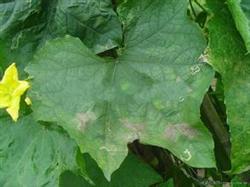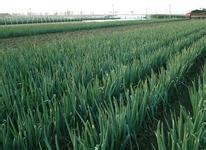High-yielding cultivation techniques of spinach and scallions in one season and double cropping

1. Spinach cultivation. The variety chooses sunken spinach with good overwintering. two。 Sowing is suitable for sowing. If sowing too early, the seeds will germinate and emerge before winter. Because of the low temperature, the seedlings grow very slowly, and the overwintering period is vulnerable to freezing because of the shallow roots of the seedlings. Sowing too late, the soil has begun to freeze, the soil preparation and sowing quality is not strict, the seeds and soil are not closely connected, and the seedlings are irregular and lack of seedlings in the following spring. The seeds can be sown when the daily average temperature drops to 2: 4 ℃. 3. After harvest, the soil preparation should be sprinkled with rotten ring manure as base fertilizer, shallow ploughing and raking, so that the fertilizer and soil can be fully mixed. After leveling the ground, build a flat bed 1.4 meters wide and prepare for sowing. Buried spinach 667 square meters dry seed sowing quantity 60.7 kilograms. If you sow germinated seeds, it is easy to freeze during overwintering. According to the line spacing of about 10 cm, the ditch depth is about 3-4 cm. Cover the soil after sowing. When sowing, if the soil is dry, it can be compacted after covering the soil, so that the seeds are closely connected with the soil; if the soil is wet, it should be compacted after the soil is slightly dry, so as to prevent the soil from hardening. Then it is allowed to survive the winter without special management, and the snow moisture in winter can meet the water demand of seed germination. 4. After the soil was thawed in early spring, the vegetable border was raked once to preserve soil moisture and increase temperature to promote seedling emergence. In early March, the seeds of buried spinach began to germinate, do not flood irrigation, so as not to lower the ground temperature, soil consolidation, hindering seedling emergence. After the seedlings grow two true leaves, the growth rate is accelerated, and the growth of the leaves is accelerated by irrigation and topdressing. For those who did not apply basic fertilizer, 10 kg of urea was applied with irrigation for the first time, and after half a month, topdressing was applied again; for those who had applied basal fertilizer, the amount and times of topdressing could be reduced appropriately according to the growth of spinach. The soil should always be kept moist after the first irrigation. 5. According to the supply situation of the market, the harvest time has been harvested and listed on the market one after another, and the harvest of green onions is finished before planting in late May. Second, the cultivation of green onions. Varieties choose Zhangqiu scallions, Zhangza series, Century Onion King and other varieties. two。 The seedling period of Welsh onion is long, and seedling transplanting is adopted during cultivation. 3. The planting time of Welsh onion is usually in early June. The later the planting, the shorter the green onion formation period and the lower the yield. at the same time, it is easy for the seedlings to grow too late, and it is not easy to slow down the seedlings in hot weather after planting. Before planting, 667 square meters were applied 2.5 tons of rotten pig manure and 20 kilograms of diammonium, and turned the soil deeply to fully mix the soil fertilizer. The ditch was opened at a row spacing of 60 cm to 70 cm, with a depth of 30 cm and a width of 15 cm. Rotten dried manure and calcium superphosphate were concentrated in the ditch, and then the bottom of the ditch was planed and planted. Take large ridges and wide rows to facilitate soil softening, plant spacing of 2 cm to 3 cm, planting 20-30 000 plants per 667 square meters, 250-300 kg of green onion seedlings. When planting, the seedlings were selected and graded, and the big seedlings were slightly thinner and the smaller ones were slightly denser. The planting depth of green onions should not be buried in the heart of green onions, too deep will not sprout, and too shallow will reduce the length of green onions. When planting, the direction of onion leaves is perpendicular to the direction of the row. 4. After the field tube ① topdressing irrigation is planted, the management center is to promote roots, not drought, not watering, drainage and waterlogging after rain, so as not to cause rotten roots, yellow leaves and dead seedlings. Strengthen ploughing to preserve soil moisture, promote root development, and slow down seedlings rapidly. Between the Beginning of Autumn and White Dew, irrigation should grasp the principles of light watering and sooner or later watering. After White Dew, the weather was cool and the temperature difference between day and night was large. Green onions began to grow vigorously and entered the green onion formation period. Topdressing is needed twice, mainly quick-acting nitrogen fertilizer, and ammonium sulfate is 15-20 kg each time. Irrigation should grasp the principle of small water and frequent irrigation. Stop watering 7-8 days before harvest to improve storability. The deeper the ② soil softens the spring onion, the longer the onion is white. The soil must be cultivated in stages during the onion formation period, and it is not suitable to cultivate the soil in the high temperature and humidity season, otherwise it is easy to cause root and pseudostem rot. 5. Disease and insect pest control of green onion blight control: onion and garlic vegetables will not be planted in the affected area within 2 to 3 years. After harvest, the disease and debris will be removed and buried or burned. Adopt ridging cultivation and cultivate soil in time. Compost made by retting with enzyme bacteria can increase plant disease resistance by applying less rapidly available nitrogen. At the initial stage of the disease, 20% Ludebao suspension was sprayed 400 times 500 times, or 77% chlorpromazine wettable particulate powder 500 times, 60% ethyl succinate aluminum wettable powder 500 times, 72% Kelu wettable powder or 72% frost urea manganese zinc wettable powder, 72% frost cyanide wettable powder 800 times, once every 10 days, twice in a row. When the above fungicides produce drug resistance, 69% Anke manganese zinc wettable powder or 1000 times water dispersible granule can be used for prevention and control. Green onion pest control: first of all, strict quarantine to prevent the spread of insect pests. Secondly, in areas where insect pests are serious, green onions are interplanted with legumes or other crops that are not harmed. Third, properly sparse planting to increase field permeability. The fourth is to clean the field in time and bury the diseased remains of the endangered crops deeply, rett fertilizer or burn them. Fifth, fly-killing paper was used to trap and kill adults. From the beginning to the end of the adult, 15 trapping points were set up every 667 square meters, and a piece of fly-trapping paper was placed at each point, and it was replaced once every 3-4 days. Sixth, the scientific use of drugs. When there are 5 larvae on the leaves of the damaged crops, spray 1.8% Alftin EC 3000 / 4000 times or 48% Lesbon EC 800 / 1000 times and 50% maggot powder 2000 times before the 2nd instar of the larvae.
- Prev

High-yield cultivation techniques of Welsh Onion
First, raising seedlings: 1. Sowing time: according to the different requirements of the products, the seeds can be sown in four seasons. The best sowing time for high-yield Welsh onion is autumn sowing (the ten-day average temperature is 16.5 ℃-17 ℃, which is in the first ten days of October). The climatic conditions of the north and south of the country are different, the sowing time is also different, the best time to determine.
- Next

Planting management technology of towel gourd
Sowing and raising seedlings in the first and middle of March. Varieties can choose Hangzhou iron towel gourd, Linhai white towel gourd and other local varieties, the seed consumption per mu is 20O-300 grams. April (1) planting: towel gourd likes fertile and humus-rich soil. Turn deeply and level out to make the bed. The width of the border (connected ditch) is 2.6 Mill 3.3 meters, each row, the hole distance is 50 cm.
Related
- Where is it suitable to grow horseradish in China? it is expected to see the middle altitude horseradish in Alishan.
- How to prevent tomato virus disease reasonably? (Control methods included)
- Many people like to plant towel gourd on the balcony. What are the main points of this method and management?
- What crops can chili peppers be mixed with?
- Fertilization techniques and matters needing attention in Tomato
- What are the grafting techniques for peach seedlings in spring?
- Harm and control methods of root swelling disease of Chinese cabbage
- What are the pests of sweet potatoes? How to prevent and cure it?
- Symptoms, causes and Control methods of navel Rot in Tomato
- The cause of "Cucumber rotten bibcock" in Farmers' planting Cucumber and its Control Plan

